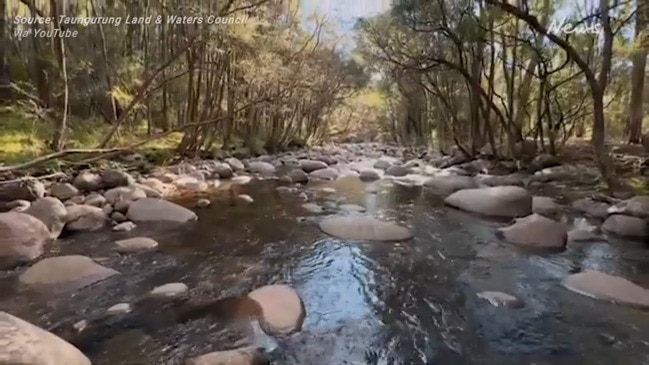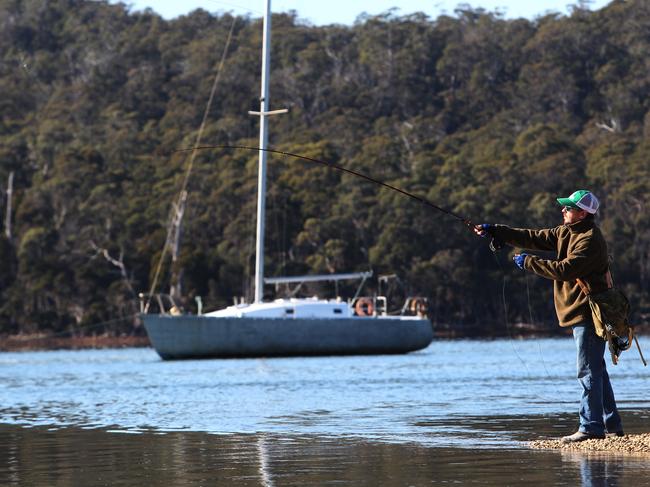‘Funding this important case will safeguard the future of this beautiful river and Taungurung cultural heritage’: TLaWC
An Aboriginal council that has legally challenged a state water authority over a river licence is seeking donations so it can ramp up its battle, saying the case is important and “the fight is not over”.

Victoria
Don't miss out on the headlines from Victoria. Followed categories will be added to My News.
A peak Aboriginal council that has legally challenged a Victorian statutory authority over the granting of a Rubicon River water licence for a mini hydro-electricity plant is now calling for public donations so it can keep up its fight.
In a statement on Wednesday afternoon, the Taungurung Land and Waters Council (TLaWC) told the Herald Sun it had launched a fundraising campaign “to cover travel costs, filing fees, and expert costs” associated with its costly court battle.
It is seeking to raise $400,000,
“Funding this important case will safeguard the future of this beautiful river and Taungurung cultural heritage,” TLaWC said.
While the TLaWC — as traditional owners — had successfully challenged a licence that it believed was “unlawful”, amid claims would have permitted a river in Victoria’s high country to be dammed and diverted, the future of the Rubicon River remained uncertain, it said.

The TLaWC has been successful in seeking a review of a licence granted in November 2023 by Goulburn Murray Water (GMW) to Rubicon Station for work needed to build a mini hydro-electricity plant.
In making an order on June 19 over the disputed licence, Victorian Civil and Administrative Tribunal (VCAT) deputy president Teresa Bisucci vacated planned hearings set down for October 28 to 31, and 12 days between November 6 to 22, and sent the matter back to GMW for review.
Rubicon Station — located about 20 km southeast of Alexandra — has also applied to use water from the Rubicon River for its planned mini hydro-electricity plant, but this licence has not yet been granted.
The TLaWC argued the planned river works would cause a damaging diversion in the river — something Ms Bisucci disagreed with.
“This may not be the end of the matter. It remains open to the decision-maker to reconsider the matter and issue new licences. TLaWC continues to insist that no licences for these works and diversion should be issued, maintaining that these actions would seriously compromise the environmental and cultural values of this waterway,” TLaWC said in its statement.
TLaWC chief executive officer Matthew Burns told the Herald Sun the Rubicon River and adjacent Camp Jungai were “part of a broader cultural landscape on Taungurung Country that have deep connections with our history, Ancestors and our obligations to care for Country”.

“Taungurung people have cared for this Country for 1000 generations, dedicated to keeping the waterways healthy and full,” he said.
“TLaWC prioritises protecting, enhancing and restoring habitats for local flora and fauna, which does not align with the serious interference in a public river for personal use.
“The (VCAT) decision … to set aside the licence for reconsideration is a partial win for the Taungurung Nation, but the fight is not over.
“Our focus is to maintain Taungurung cultural values, limit negative environmental impacts and improve ecological conditions; advocating for healthy waterways to ensure everyone can enjoy these beautiful spaces on Taungurung Country for a thousand generations to come.”
TLaWC was represented in court by public interest legal group Environmental Justice Australia (EJA).
EJA lawyer Bruce Lindsay said on Wednesday that, in its decision, VCAT had clarified some important points about how Victorian rivers and waterways were managed.
“Licences to manage how water and waterways in Victoria may be used and interfered with
must be properly assessed and lawfully granted,” he said.
“It appears unlikely that these issues are yet resolved. The decision on use of water and the Rubicon River for the private hydropower scheme will go back to a decision-maker, whether GMW or the Minister directly.
“This is an important and ecologically healthy waterway to which the Aboriginal Traditional Owners have very strong cultural ties. These are matters of significant public interest. Maintaining an ecologically healthy waterway is in the public interest.
“Building private hydropower schemes on public waterways, for private gain, raises important questions of public policy. Where that might occur on healthy mountain streams, with strong Aboriginal cultural associations, invokes the need for careful scrutiny.
“Our client will continue to follow the next steps in this process closely.”

The corporate representative of the Taungurung people — whose land covers much of central and north eastern Victoria — TLaWC was established in 2003 “to advocate for Taungurung recognition and land management rights”.
Taungurung country goes to the Campaspe River in the east, nearly to Echuca in the north (just south of where the Campaspe meets the Murray), down to Murchison, over to Mooroopna and to the Ovens and Broken rivers in the east, near Wangaratta and Bright.
TLaWC was given Registered Aboriginal Party status in 2009, which allowed for the management of cultural heritage across Taungurung country.
In 2018 is reached a historic settlement with the Victorian government through a Recognition and Settlement Agreement (RSA) that started on August 11, 2020.
The settlement agreement formally recognises the Taungurung people as the traditional owners of a large part of Victoria.
The government package includes funding to support the TLaWC manage the settlement agreement’s benefits and undertake economic development, measures to strengthen culture, grants of parks and reserves as Aboriginal title and up to five public land parcels as freehold title, a regime for managing activity on public land, and resourcing and strategies for the Taungurung people to access, use and manage natural resources.

The TLaWC has said the formal recognition creates many new opportunities for the Taungurung people, including ensuring their voice is clearly heard in relation to any significant activities on crown land in their territory.
TLaWC chief executive officer Matt Burns has been elected as the Taungurung representative for the First Peoples Assembly of Victoria — the body elected to represent traditional owners and Aboriginal communities in the next phase of Treaty negotiations.
The TLaWC say “Treaty will provide a way to tackle the racist legacies of invasion and offer everyone an opportunity to create a better future together”.
In her preliminary hearing ruling, Ms Bisucci found Goulburn Murray Water had the authority to grant the licence to Rubicon, but there were nonetheless issues that warranted a review.
“The decision of Goulburn Murray Water to issue Licence WLE086675 to construct works on a waterway is set aside and remitted to Goulburn Murray Water for reconsideration in accordance with the provisions of the Water Act 1989 (Vic),” Ms Bisucci said.
Ms Bisucci said she had been called on to consider questions of law by TLaWC, including whether GMW had authority to make the decision to grant the licence, whether the Rubicon works would cause a deviation of the waterway and whether there was a related Rubicon application before the water authority at the time.

“In summary the applicant says the proposed works include works that will deviate a waterway and therefore GMW lacked delegated power to make the decision, and GMW was required to defer the making of the decision … because GMW has not yet decided upon Rubicon’s ‘related application’ for the take and use of water,” she noted.
“GMW opposes the position of TLWC and contends that the proposed works will not deviate the waterway and it was not required to defer its decision because there is no related application under … the Water Act,” Ms Bisucci noted.
Rubicon’s proposed works include a power station, a weir in the Rubicon River, an intake structure for diversion of flows, concrete piping, a power station, an outfall structure for return flows to the Rubicon River about 595 metres downstream of the diversion weir and a constructed rock ramp fishway, also downstream of the weir, VCAT documents show.

Central to TLaWC’s challenge was fears over a deviation in the river, Ms Bisucci said.
“TLWC says that the proposed works will materially alter the course of the Rubicon River by creating an alternative flow path between the new intake and outfall structures,” she noted.
“GMW submits the proposed works are not works, nor do they include works, which deviate the Rubicon River … I agree with GMW that the proposed works do not cause the Rubicon River to turn aside from its existing or natural course nor do they cause it to swerve. There is no change to the course of the Rubicon River. Rather, the proposed works will facilitate some of the water in the waterway to be taken or diverted by the proposed works, used and then returned to the waterway.”
The licence granted by GMW is for Rubicon Station Pty Ltd to construct works on a waterway, on land at 441 Rubicon Road, Rubicon.
GMW said would not provide further comment while the matter was before the courts.
The TLaWC has said in public documents it plans to explore payments for ecosystem and cultural services schemes, and apply property management approaches on private land “within priority cultural landscapes”.
TLaWC’s cultural water program includes assessing values, identifying important waterscapes and applying flow regimes, with “a crucial element” being reform of institutional and governance arrangements for water policy and programs.
Parks and reserves granted to the Taungurung as Aboriginal title under its RSA with the Victorian government include part of Alpine National Park, Heathcote-Graytown National Park, part of Kinglake National Park, Lake Eildon National Park, Mt Buffalo National Park, Mt Samira State Park, Cathedral Range State Park, Wandong Regional Park and Mount Wombat-Garden Range Flora and Fauna Reserve.
In a March 2024 newsletter the TLaWC called for Indigenous community members to put forward names of places they believed were offensive in English, for potential name changes.
Nearly 40,000 sites and objects are now recorded on the Victorian government’s Aboriginal Heritage Register, as it continues to back a treaty and refuses to rule out giving compulsorily acquired private property to Indigenous groups.
“The register holds information about known Aboriginal cultural heritage places and objects within Victoria,” the state government notes on the register’s website.
“Over 39,000 Aboriginal objects and places have been recorded on the register and many of these places and objects are located on private property. There are still many Aboriginal places and objects yet to be discovered.”
Not viewable by most Victorians, the register is only accessible to people or organisations who need detailed information on Aboriginal cultural heritage places and objects in order to protect and manage them, as it contains culturally sensitive information, it adds.
This includes landowners who believe they may have Aboriginal cultural heritage places or sites — such as scarred trees, occupation sites or places of burial — on their properties, but they must first apply for access to the register. They will then be contacted by the Heritage Registrar.


